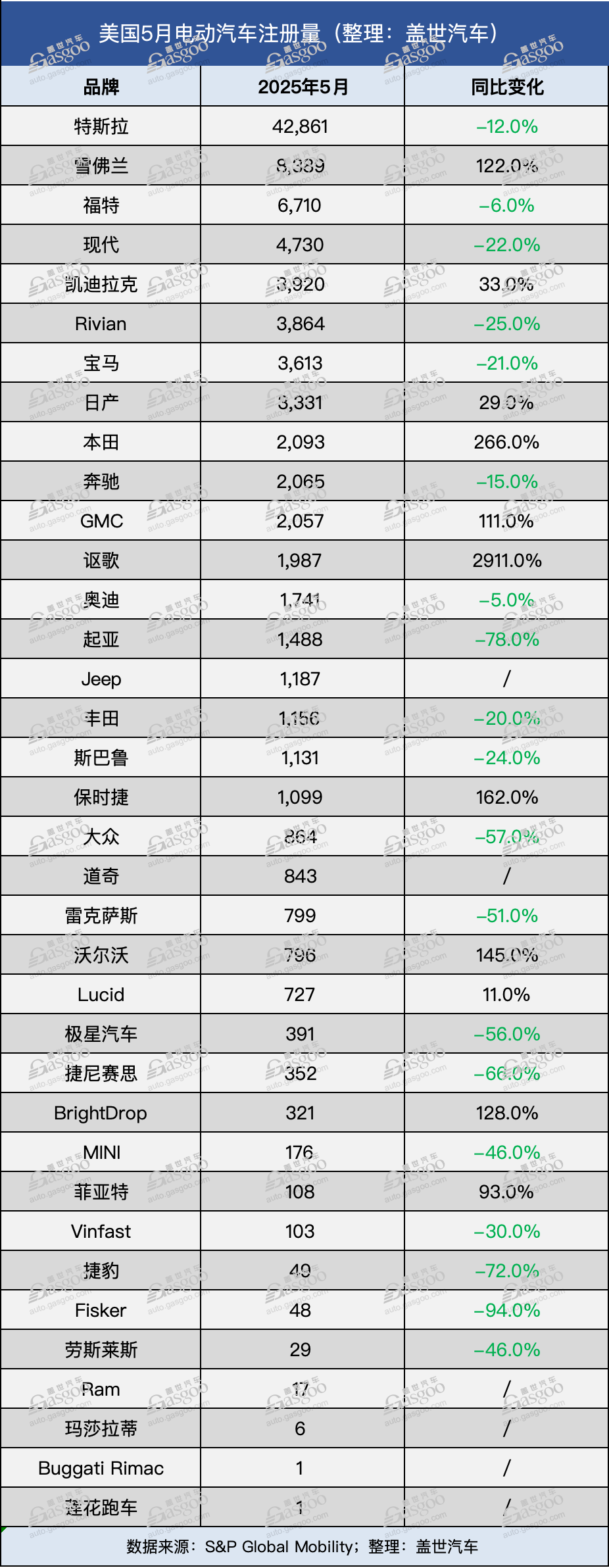Despite manufacturers offering discounts and the government implementing tax incentives that have brought electric vehicle prices close to those of gasoline vehicles, the registration of pure electric vehicles in the U.S. fell again in May. According to S&P Global Mobility, the overall registration of light vehicles in the U.S. saw a slight decline of 1% in May, totaling approximately 1.4 million vehicles. However, for the first five months of this year, the registration of light vehicles in the U.S. grew by 4.7% to 6.9 million. In May, the registration of new electric vehicles in the U.S. declined by 5.9% compared to the same period last year, totaling 99,053 vehicles, which accounted for 7.1% of the U.S. light vehicle market that month, down from 7.5% in May 2024. This marks the second consecutive month of decline in monthly electric vehicle registrations since April. It is important to note that this data does not include hybrid vehicles. Nevertheless, from January to May this year, the registration of electric vehicles in the U.S. was still higher than the same period last year, increasing by 7.4% to 506,807 vehicles, maintaining a stable market share of 7.3%. In terms of brands, Tesla, the leader in electric vehicles, continues to see a decline in registrations. In May, the company's registrations in the U.S. fell by 12% to 42,861 vehicles. Over the past 18 months, Tesla has updated its best-selling models, the Model Y and Model 3, but these models are still considered first-generation products. The Tesla Cybertruck, which is set to be released in November 2023, has already begun to see a drop in sales, with May registrations down 54% year-on-year to just 1,806 vehicles. In contrast, new models from General Motors have seen strong growth in registrations. Chevrolet's electric vehicle registrations soared by 122% in May to 8,389 vehicles; Cadillac experienced a 33% increase to 3,920 vehicles; and GMC surged by 111% to 2,057 vehicles. Besides the Tesla Model Y and Model 3, the Chevrolet Equinox EV, which has only been on the market for a year, was the only electric vehicle in the U.S. to surpass 5,000 sales in May. Additionally, Rivian's R1S crossover saw a 30% drop in registrations year-on-year in May to just 1,947 vehicles, while the new Acura ZDX's registrations skyrocketed from 66 last year to 1,987 this May. The expiration of tax credit policies will impact electric vehicle development. According to Automotive News, the path to widespread adoption of electric vehicles in the U.S. remains challenging, even before the $7,500 electric vehicle tax credit expires on September 30. S&P Global analyst Tom Libby stated, "Overall, the performance of electric vehicles in May was quite mediocre." Libby mentioned that while electric vehicles typically have higher prices than gasoline or hybrid vehicles, manufacturer discounts and government subsidies have narrowed the price gap. The poor sales of electric vehicles indicate issues beyond pricing, including concerns over range, charging infrastructure, and product offerings. Cox Automotive reported on June 19 that the average transaction price for new electric vehicles in the U.S. in May was $57,734, which is $9,644 higher than that of non-electric vehicles. However, each electric vehicle had an average discount of $8,226, more than double that of non-electric vehicles. Cox indicated that many electric vehicle models, including the Acura ZDX, Kia EV6, Ford Mustang Mach-E, and Nissan Ariya, have actual prices below $40,000 when accounting for model-specific average discount amounts from the average transaction price. Ed Kim, president of AutoPacific, noted that popular models such as the Honda Civic and Subaru Forester offer hybrid versions that are very attractive, leading some consumers to abandon pure electric models. "Hybrids do not require drivers to change any driving behavior. For many, it's a simpler way to achieve higher efficiency." Cox estimated that in May, the inventory days for electric vehicles in the U.S. averaged 111 days, about 30 days longer than that of gasoline and hybrid vehicles. Kim pointed out that generous subsidies, low-interest loans, lease agreements, and government incentives suggest that many car buyers do not prioritize electric vehicles as much as similarly equipped gasoline vehicles and often expect significant discounts before purchasing. Analysts stated that electric vehicle sales have also been significantly impacted by the ever-changing regulatory environment. Following Donald Trump's election as U.S. president last November, electric vehicle sales surged as consumers sought to take advantage of the subsidy before it was potentially eliminated. However, the U.S. electric vehicle market then entered a brief period of calm. Kim noted that in April and May, electric vehicle sales declined as consumers had completed their purchasing plans in advance. In early July, a comprehensive tax and budget bill passed by Congress announced the cancellation of the $7,500 tax credit for purchasing or leasing new electric vehicles, along with a $4,000 tax credit for used electric vehicles, by the end of September. Kim believes that "in the coming months, we may see a new wave of panic buying of electric vehicles. There is currently a large inventory of electric vehicles on the market," and without government subsidies, even if electric vehicle sales show an upward trend this summer, they will likely slow after the fall. In addition to the cancellation of tax subsidies, electric vehicles are also facing higher costs due to automotive tariffs implemented since April. Analysts indicate that even models assembled in the U.S. contain some imported parts. In recent months, several automakers have canceled some electric vehicle investment plans. Kim stated, "As we approach the end of the year, the market share of electric vehicles may gradually decrease as tax subsidies are removed, and electric vehicle prices are likely to rise significantly."
Decline in Electric Vehicle Registrations in the U.S. Continues Despite Discounts and Incentives

Share this post on: